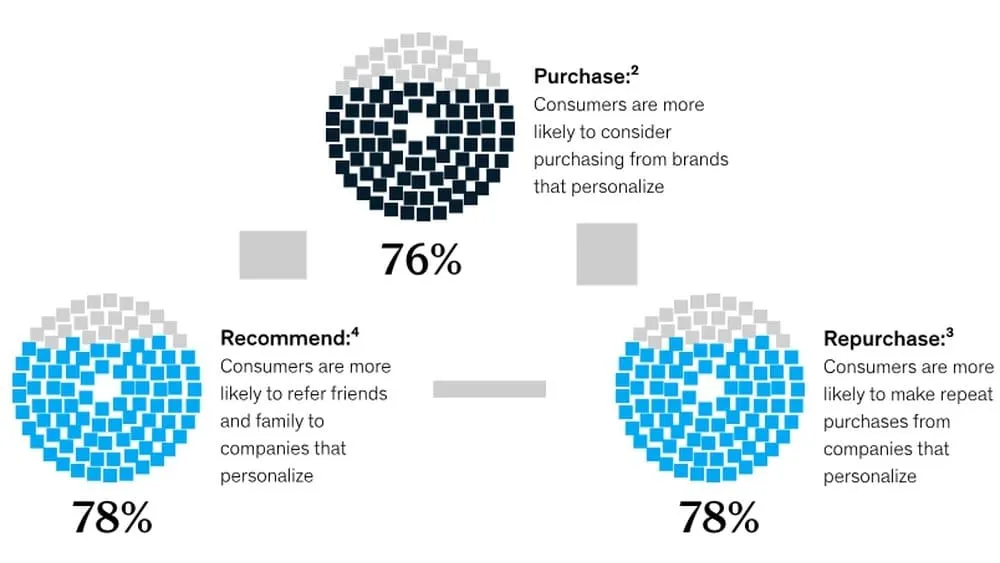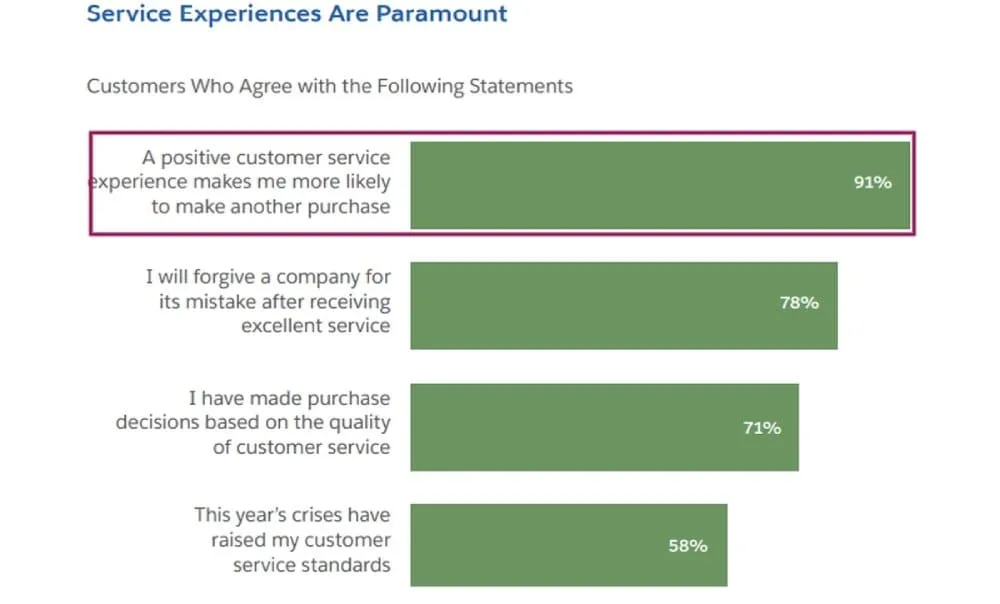
10 Strategies for Building Strong Relationships with Customers for Repeat Sales
February 29, 2024
Build customer loyalty like never before! Dive into foolproof strategies for cultivating strong customer relationships and driving repeat sales. Elevate your business today!

Did you know that 80% of customers will purchase products or services from the same company again after having a fantastic experience?
That’s the power of building strong customer relationships.
While offering the best products on the market is essential for business success, it’s not the only key to securing continuous sales.
The secret to keeping customers buying from you regularly is to build and maintain solid, mutually beneficial customer relationships.
However, in today’s fast-paced world, where customer expectations are skyrocketing, achieving better customer relationships isn’t easy.
Fret not—in this article, I will share practical strategies for building solid relationships with customers to keep them coming back for more.
Let’s get started.
Proven Strategies for Building Strong Customer Relationships
#1. Know Your Customers Inside Out
To build solid customer relationships, you need to know your customers deeply.
By knowing your customers inside out through research and persona creation, businesses can better align their products, services, and communication strategies with the preferences and expectations of their target audience.
This understanding forms the foundation for building meaningful and lasting relationships with customers.
But this isn’t easy, as 86% of business executives in a survey agree that getting a complete understanding of their customers from analyzing data alone is difficult.
So, you need to develop a strategy for understanding your customers better.
First, conduct comprehensive customer research. In this case, you must gather detailed customer information to understand their preferences, behaviors, needs, expectations, and challenges.
To gather enough information about your customers, you may conduct surveys, interviews, and other methods to collect valuable insights.
Once you have collected in-depth insights about your customers, create detailed buyer personas to classify your customers based on their demographics, preferences, motivations, and pain points. Developing detailed personas will help you humanize your customer base and tailor your strategies to meet their specific needs.
#2. Personalize the Customer Experience
Today’s customers demand personalization more than ever. This is evident in a McKinsey & Company survey where 78% of customers say they will likely purchase again from a company that personalizes their experience.

Source: McKinsey & Company
According to the survey, customers want companies to give them relevant products/service recommendations, tailor messaging to their needs, offer them targeted promotions, and address communications to them.
By personalizing the customer experience, you build stronger customer relationships and make your customers feel more appreciated and engaged.
This leads to increased customer satisfaction and loyalty, higher conversion rates and sales, and improved brand perception and advocacy.
Here is how to personalize the customer experience to boost customer relationships:
Based on the information you gathered about your customers, tailor products/services better to meet individual customer requirements, needs, and expectations.
This could involve offering personalized recommendations, flexible customization options, etc.
Ditch the one-size-fits-all communication and personalize messaging based on the data collected. This could include addressing customers by name, sending targeted and relevant content, utilizing personalized language, offering multiple communication channels, etc.
#3. Provide Exceptional Customer Service
Another practical approach to building strong customer relationships and generating repeat sales is to deliver outstanding customer service.
Here is the proof:
According to a Salesforce study, 91% of respondents say a positive customer service experience makes them more likely to make repeat purchases from a company:

Source: Salesforce
Note that exceptional customer service goes beyond simply solving problems. It's about creating a positive and memorable experience that fosters trust and loyalty. Here's how:
Businesses must invest in staff training to ensure they possess the necessary skills and knowledge to deliver exceptional customer service. The training may include teaching employees effective communication, problem-solving, and empathy. It also involves educating them about the products or services offered so that they can assist customers more efficiently.
The way a business handles customer issues can significantly impact the overall perception and satisfaction of the customer.
When customers encounter issues or problems, they want prompt responses from customer support.
Businesses need to have efficient customer support systems in place, providing clear channels for customers to voice their concerns and implementing quick and satisfactory resolutions.
#4. Build Trust and Credibility
In today’s competitive business landscape, trust and credibility aren’t only essential aspects of building and maintaining strong customer relationships but are drivers of repeat sales.
According to recent research by Adobe 7 in 10 Customers will buy more from brands they trust and abandon those they don’t.
Here is how to build trust and credibility:
Honesty and transparency in business practices: Businesses need to conduct their operations with honesty and transparency. This means being open about business processes, pricing, terms, conditions, etc. When customers perceive a business as transparent and truthful, it fosters trust. Avoiding deceptive practices and providing accurate information contribute to building a positive reputation and credibility.
Showcase testimonials and reviews from satisfied customers: Positive feedback from existing customers can serve as powerful endorsements for a business. Showcase testimonials and reviews on websites, marketing materials, or social media platforms to provide evidence of satisfied customers. Potential customers often rely on the experiences of others to gauge the reliability of a business. Including genuine testimonials can build credibility and influence the decision-making process positively.
#5. Offer Consistent Communication Channels
By offering consistent communication channels, businesses demonstrate their commitment to being accessible and responsive to customer needs.
This can be achieved through various ways including:
Leveraging various communication platforms. Businesses should utilize a variety of communication channels to reach and engage with their customers.
This may include traditional channels like SMS and Email, as well as modern platforms such as social media, messaging apps, and chatbots. The goal is to meet customers where they are and provide options for communication that align with their preferences.
Another way is to establish regular touchpoints with customers. Regular communication is vital for maintaining a strong relationship with customers.
This involves establishing consistent touchpoints at various stages of the customer journey. Whether it's through newsletters, updates, or personalized messages, businesses can stay connected with customers and keep them informed about new products, promotions, or any relevant information.
#6. Add Value Beyond Transactions
Another approach to building better customer relationships and enhancing the overall customer experience is to add value beyond product or service exchanges.
This involves offering exclusive deals and rewards programs. Businesses can add value by providing customers exclusive deals, discounts, or rewards programs.
These special offers incentivize customers to engage with the business repeatedly. It enhances the perceived value of the products or services and fosters a sense of appreciation and loyalty among customers.
Additionally, businesses can add value beyond the immediate transaction by offering educational content and resources related to their products or industry. This could include tutorials, how-to guides, informative articles, or webinars.
By providing valuable information, businesses position themselves as experts and resources, helping customers make informed decisions and derive more utility from their purchases.
Adding value beyond transactions contributes to building a relationship based on mutual benefit, where customers feel appreciated and engaged beyond buying a product or service. This approach often leads to increased customer loyalty and advocacy.
#7. Creating Emotional Connections
Creating emotional connections fosters deeper and more meaningful relationships with your customers. It goes beyond transactional relationships and taps into the emotional aspects of consumer behavior.
When customers feel emotionally connected to a brand, they are more likely to develop loyalty and advocate for the brand, ultimately contributing to the long-term success of the business.
This can be achieved by eliciting positive emotions through brand storytelling. Businesses can create emotional connections by telling compelling stories that resonate with their audience.
This involves going beyond the features of a product or service and delving into the values, mission, and experiences that define the brand.
Effective storytelling can evoke positive emotions such as joy, nostalgia, or inspiration, helping customers form a stronger emotional attachment to the brand.
Additionally, social media provides a powerful platform for businesses to connect with their audience on a personal level. By engaging customers through social media platforms, businesses can share behind-the-scenes content, respond to comments, and participate in conversations.
#8. Seek and Actively Listen to Feedback
Seeking and actively listening to customer feedback is crucial for building stronger customer relationships.
Encourage customer feedback through surveys and reviews to establish a channel for customers to express their thoughts and experiences.
This demonstrates a commitment to customer satisfaction and provides valuable insights into their expectations. The crucial next step is to actively listen and, more importantly, implement changes based on customer input.
This proactive approach shows that you value and prioritize the opinions of your customers, fostering a sense of partnership.
By incorporating customer suggestions and addressing concerns, you not only enhance your products and services but also convey a responsiveness that strengthens the trust and loyalty of your customer base, ultimately contributing to the longevity of the relationship.
#9. Reward Loyalty and Advocacy
Building strong relationships with customers is crucial for the success of any business. One effective way to strengthen these relationships is by rewarding loyalty and advocacy. Here are two practical strategies to implement this approach:
Implement loyalty programs with tangible benefits: Incentivize customers to continue buying from you by giving them exclusive offers, discounts, free products, etc. This could be through rewarding customers for repeat purchases or consistently engaging with your business. By providing these incentives, you encourage repeat business and make customers feel valued and appreciated for their ongoing loyalty.
Encourage customer advocacy through referral programs: Implement referral programs to encourage satisfied customers to promote and recommend your business to others.
Referral programs are a structured way to encourage and reward customers for becoming advocates. You can offer incentives such as discounts, credits, or special access to both the existing customer and the new customer they refer. This helps acquire new customers through word-of-mouth marketing and strengthens the bond with existing customers who feel recognized for their advocacy. Additionally, referral programs can create a positive cycle where satisfied customers bring in new business, further contributing to the growth of the customer base. An excellent example of encouraging customer advocacy comes from the Cloudways cloud hosting program. Through their referral program, existing customers can get new people onboard and in return, get free money within the platform to spend on their hosting. It’s a never-ending free trial offer from this hosting provider.
#10. Analyze and Adapt Strategies
Building and maintaining strong relationships with customers requires an ongoing effort and a willingness to adapt to changing circumstances. This involves continuously analyzing the effectiveness of relationship-building efforts and making adjustments based on insights gained from key metrics. Here's a breakdown of the components of this strategy:
Track key metrics to evaluate relationship-building efforts: To understand the success of relationship-building strategies, you need to monitor key metrics that reflect customer engagement, satisfaction, and overall experience. These metrics may include customer feedback, Net Promoter Score (NPS), customer retention rates, and other relevant indicators. By systematically tracking and analyzing these metrics, you will gain valuable insights into the impact of their efforts on customer relationships.
Iterate and improve strategies based on data insights: Once you collect and analyze the relevant metrics, the next step is to iterate and improve strategies based on the insights gained. If certain initiatives or campaigns are proving particularly effective, you can scale them up. On the other hand, if certain aspects are not yielding the desired results, make adjustments to refine or replace those strategies. This iterative process allows you to stay responsive to evolving customer needs and preferences, ensuring that your relationship-building efforts remain relevant and effective over time.
FAQs
What should I do if a customer relationship becomes strained?
If a customer relationship becomes strained, promptly address concerns, actively listen to the customer's perspective, and offer viable solutions.
Communication is key; demonstrate empathy, take responsibility for any shortcomings, and work collaboratively to rebuild trust. Consistent follow-up and ongoing support can help repair the relationship and turn a negative experience into a positive one.
How long does it typically take to see results from relationship-building efforts?
The timeline for seeing results from relationship-building efforts varies, but typically, positive outcomes become apparent within weeks to months.
Building strong customer relationships is a gradual process that requires consistent effort. Immediate improvements may be observed, but the full impact, such as increased loyalty and customer advocacy, often becomes more evident over time with sustained engagement and positive interactions.
Key Takeaways for Building Strong Customer Relationships
Successful customer relationship building doesn’t happen overnight. Emphasizing long-term connections over transactional interactions is crucial.
Implement loyalty programs with tangible benefits, encourage customer advocacy through referral programs, and consistently analyze and adapt strategies based on key metrics.
When relationships strain, address concerns promptly, demonstrating empathy and offering solutions.
Results from these efforts may take weeks to months, but sustained engagement and positive interactions foster customer loyalty and advocacy.
Prioritize continuous improvement and adaptability to meet evolving customer needs, ultimately creating a foundation for lasting, mutually beneficial relationships.
Related blog posts

5 LLM Visibility Metrics You Should Track in 2026
SEO is now both about ranking in search engines and being visible in LLMs. We give you five visibility metrics every SEO should track in 2026.
3 December 2025Is LLM Tracking Relevant for You?
LLM tracking is not just for SEOs. It is also relevant for content teams, agencies, marketing leadership, and communication teams. Learn why here.
26 November 2025
How to Find the Best Prompts to Track for AI Visibility
Do you want to start tracking prompts to optimize your AI visibility? We give you seven practical ways to identify relevant prompts to track in LLMs.
9 November 2025
